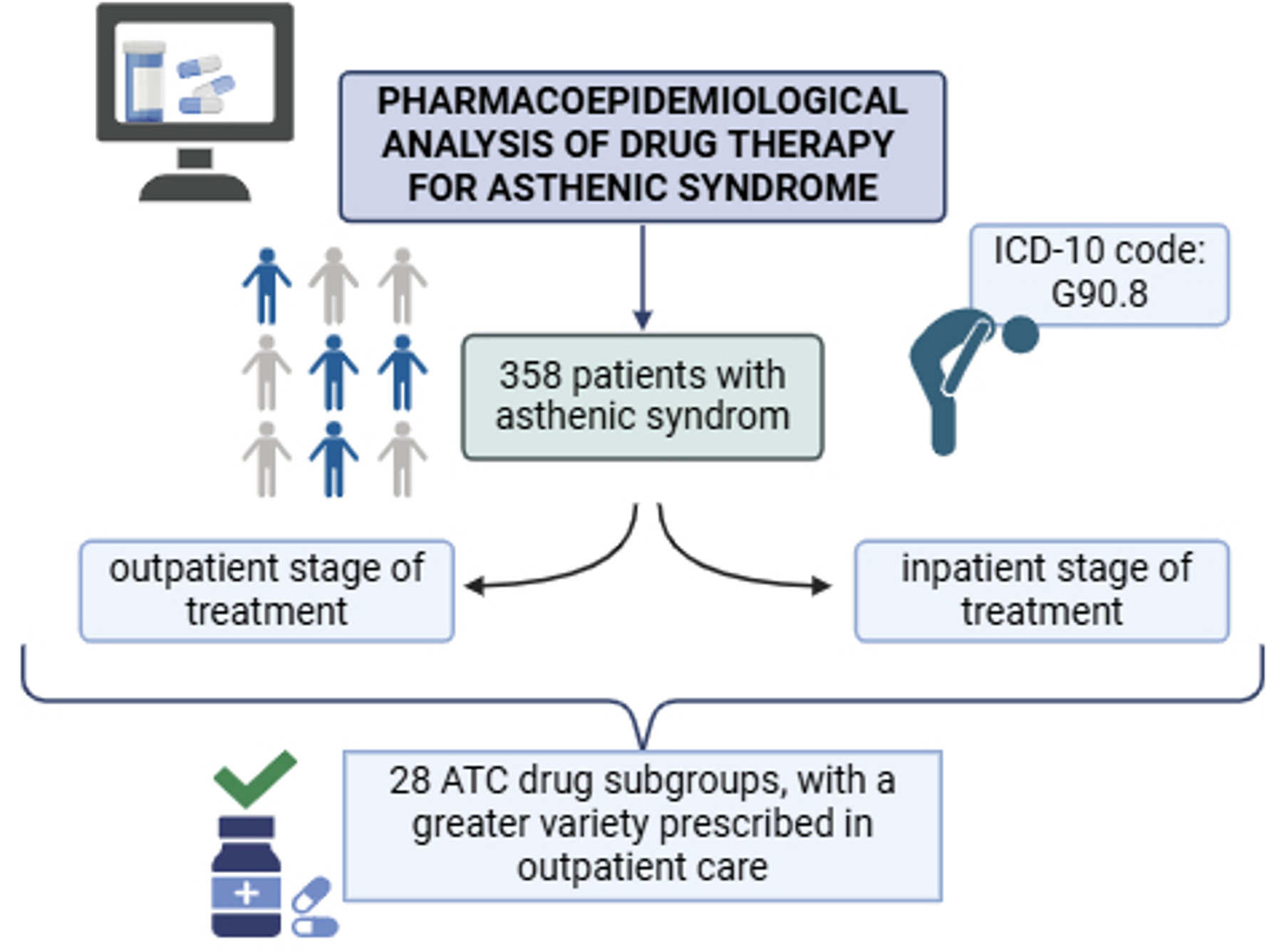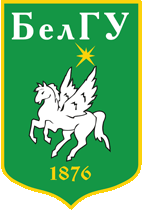Pharmacoepidemiological analysis of drug therapy for asthenic syndrome as provided in Kaliningrad region
DOI:
https://doi.org/10.18413/rrpharmacology.11.586Abstract
Introduction: Asthenic syndrome (AS) is increasingly prevalent, especially post-COVID, but its treatment lacks standardization due to unclear pathogenesis and diagnostic challenges. Current approaches rely on physician experience, underscoring the need for pharmacoepidemiological studies to optimize therapy.
Materials and Methods: This study analyzed AS drug therapy (ICD-10 G90.8) in Kaliningrad region. A retrospective cross-sectional study of 358 patients (82 males, 276 females) evaluated outpatient and inpatient treatment using healthcare database records. Data were processed using Microsoft Access, Excel, and Statistica 13.3, with descriptive statistics (mean, median, mode, etc.).
Results and Discussion: Showed 77% of AS patients were female, with monotherapy predominant (69.3% outpatients, 61.8% inpatients). Key drug subgroups included N07XX (48% outpatients, 66% inpatients – mainly succinic acid combinations) and N06BX (18% outpatients, 23% inpatients – primarily vinpocetine).
Conclusion: Overall, 28 ATC drug subgroups were used, with greater variety in outpatient care. Common medications were ethylmethylhydroxyperidine succinate (EMHPS) and combinations of inosine, nicotinamide, and riboflavin. The findings highlight inconsistent prescribing patterns and the need for standardized protocols to reduce polypharmacy and improve outcomes.
Graphical Abstract

Keywords:
asthenia, pharmacotherapy, pharmacoepidemiological study, real-world clinical practiceReferences
Abakumova M, Tyurenkov I (2011) Analysis of doctors' preferences in prescribing nootropic drugs on the example of Volgograd region. Journal of New Medical Technologies [Vestnik Novykh Meditsinskikh Tekhnologii] 18(1): 61–63. [in Russian]
Alkodaymi MS, Omrani OA, Ashraf N, Shaar BA, Almamlouk R, Riaz M, Obeidat M, Obeidat Y, Gerberi D, Taha RM, Kashour Z, Kashour T, Berbari EF, Alkattan K, Tleyjeh IM (2022) Prevalence of post-acute COVID-19 syndrome symptoms at different follow-up periods: a systematic review and meta-analysis. Clinical Microbiology and Infection 28(5): 657–666. https://doi.org/10.1016/j.cmi.2022.01.014 [PubMed] [PMC]
Belousova YD, Tynterova AM, Rafalskiy VV (2024) Modern doctors’ view on the problem of diagnostics and treatment of asthenic syndrome in different regions of the Russian Federation. Research Results in Pharmacology 10(1): 7–13. https://doi.org/10.18413/rrpharmacology.10.398
Bontsevich RA (2024) Educational pharmacoepidemiology and “Real-World Knowledge”. Real-World Data & Evidence [Real'naya Klinicheskaya Praktika: Dannye i Dokazatel'stva] 4(4): 44–52. https://doi.org/10.37489/2782-3784-myrwd-062 [in Russian]
Chutko LS, Surushkina SY (2020) Asthenic disorders. History and modernity. S.S. Korsakov Journal of Neurology and Psychiatry [Zhurnal Nevrologii i Psikhiatrii imeni S.S. Korsakova] 120(6): 131–136. https://doi.org/10.17116/jnevro2020120061131 [in Russian]
Crescioli G, Bonaiuti R, Corradetti R, Mannaioni G, Vannacci A, Lombardi N (2022) Pharmacovigilance and pharmacoepidemiology as a guarantee of patient safety: The role of the clinical pharmacologist. Journal of Clinical Medicine 11(12): 3552. https://doi.org/10.3390/jcm11123552 [PubMed] [PMC]
Dovgun S, Demidova M (2012) Frequency of use and structure of prescribing nootropic drugs in the treatment of acute cerebral circulation disorder. Modern Problems of Science and Education [Sovremennye Problemy Nauki i Obrazovaniya] 3: 350. [in Russian]
Dyukova G (2012) Asthenic syndrome: problems of diagnosis and therapy. Efficient P Neurology and Psychiatry [Effektivnaya Farmakoterapiya. Nevrologiya i Psikhiatriya] 1: 16–22. [in Russian]
Ebzeyeva EY, Ostroumova OD, Krotkova IF, Doldo NM, Khaletskaya A (2023) Asthenic syndrome in outpatient practice (clinical observations). Russian Medical Journal 5: 43–48. [in Russian]
Khaibullina DK, Maksimov YN (2023) Asthenic post-COVID syndrome. S.S. Korsakov Journal of Neurology and Psychiatry [Zhurnal Nevrologii i Psikhiatrii imeni S.S. Korsakova] 123(3): 61–69. https://doi.org/10.17116/jnevro202312303161 [in Russian]
Kotova O, Akarachkova E (2016) Asthenic syndrome in neurological and family doctor practice. RMJ 13: 824–829. [in Russian]
Medvedev V, Frolova V, Gushanskaya E, Kotova O, Zuikova N, Palin A (2021) Asthenic disorders within the framework of postcovid S.S. Korsakov Journal of Neurology and Psychiatry [Zhurnal Nevrologii i Psikhiatrii imeni S.S. Korsakova] 121(4): 152–158. https://doi.org/10.17116/jnevro2021121041152 [in Russian]
Shmyrev VI, Vasiliev AS, Demyanovskaya EG (2023) Modern concept. Lechaschi Vrach [Physician] 10(26). https://doi.org/10.51793/os.2023.26.10.003 [in Russian]
Tkacheva ON, Kotovskaya YuV, Runikhina NK, Frolova EV, Naumov AV, Vorobyeva NM, Ostapenko VS, Mkhitaryan EA, Sharashkina NV, Tyukhmenev EA, Pereverzev AP, Dudinskaya EN (2020) Clinical recommendations “Senile asthenia”. Russian Journal of Geriatric Medicine [Rossiiskii Zhurnal Geriatricheskoj Meditsiny] 1: 11–46.https://doi.org/10.37586/2686-8636-1-2020-11-46 [in Russian]
Published
How to Cite
Issue
Section
License
Copyright (c) 2025 Belousova YaD, Kryukova NO, Filimonkina IuA, Rafalskiy VV

This work is licensed under a Creative Commons Attribution 4.0 International License.
 Русский
Русский
 English
English

